Etravirine
Editor-In-Chief: C. Michael Gibson, M.S., M.D. [1]; Associate Editor(s)-in-Chief: Kiran Singh, M.D. [2]
Disclaimer
WikiDoc MAKES NO GUARANTEE OF VALIDITY. WikiDoc is not a professional health care provider, nor is it a suitable replacement for a licensed healthcare provider. WikiDoc is intended to be an educational tool, not a tool for any form of healthcare delivery. The educational content on WikiDoc drug pages is based upon the FDA package insert, National Library of Medicine content and practice guidelines / consensus statements. WikiDoc does not promote the administration of any medication or device that is not consistent with its labeling. Please read our full disclaimer here.
Overview
Etravirine is an antiretroviral drug that is FDA approved for the treatment of HIV-1 infection in treatment-experienced patients 6 years of age and older with viral strains resistant to an NNRTI and other antiretroviral agents,and In patients who have experienced virologic failure on an NNRTI.. Common adverse reactions include peripheral neuropathy, rash,skin and subcutaneous tissue disorders,myocardial infarction, angina pectoris, atrial fibrillation,vertigo, hemolytic anemia,gynecomastia.
Adult Indications and Dosage
FDA-Labeled Indications and Dosage (Adult)
Indications
- INTELENCE®1, in combination with other antiretroviral agents, is indicated for the treatment of human immunodeficiency virus type 1 (HIV-1) infection in antiretroviral treatment-experienced patients ages 6 years and older, who have evidence of viral replication and HIV-1 strains resistant to a non-nucleoside reverse transcriptase inhibitor (NNRTI) and other antiretroviral agents.
- The indication for adult use is based on Week 48 analyses from 2 randomized, double-blind, placebo-controlled trials of INTELENCE®. Both studies were conducted in clinically advanced, 3-class antiretroviral (NNRTI, N[t]RTI, PI) treatment-experienced adults. The indication for pediatric use is based on 24-week analyses of a single-arm, Phase 2 trial in antiretroviral treatment-experienced pediatric subjects 6 years to less than 18 years of age.
- In treatment-experienced adult and pediatric patients, the following points should be considered when initiating therapy with INTELENCE®:
- Treatment history and resistance testing should guide the use of INTELENCE® due to concerns for potential cross-resistance .
- In patients who have experienced virologic failure on an NNRTI-containing regimen, do not use INTELENCE® in combination with only N[t]RTIs .
- The use of other active antiretroviral agents with INTELENCE® is associated with an increased likelihood of treatment response.
- The safety and efficacy of INTELENCE® have not been established in treatment-naïve adult patients.
Dosage
The recommended oral dose of INTELENCE® tablets is 200 mg (one 200 mg tablet or two 100 mg tablets) taken twice daily following a meal. The type of food does not affect the exposure to etravirine.
DOSAGE FORMS AND STRENGTHS
INTELENCE® 25 mg Tablets
- INTELENCE® 25 mg tablets are supplied as white to off-white, oval, scored tablets debossed with "TMC" on one side.
INTELENCE® 100 mg Tablets
- INTELENCE® 100 mg tablets are supplied as white to off-white oval tablets debossed with "TMC125" on one side and "100" on the other side.
INTELENCE® 200 mg Tablets
- INTELENCE® 200 mg tablets are supplied as white to off-white, biconvex, oblong tablets debossed with "T200" on one side.
Off-Label Use and Dosage (Adult)
Guideline-Supported Use
There is limited information regarding Off-Label Guideline-Supported Use of Etravirine in adult patients.
Non–Guideline-Supported Use
There is limited information regarding Off-Label Non–Guideline-Supported Use of Etravirine in adult patients.
Pediatric Indications and Dosage
FDA-Labeled Indications and Dosage (Pediatric)
Indications
- INTELENCE®1, in combination with other antiretroviral agents, is indicated for the treatment of human immunodeficiency virus type 1 (HIV-1) infection in antiretroviral treatment-experienced patients ages 6 years and older, who have evidence of viral replication and HIV-1 strains resistant to a non-nucleoside reverse transcriptase inhibitor (NNRTI) and other antiretroviral agents.
- The indication for adult use is based on Week 48 analyses from 2 randomized, double-blind, placebo-controlled trials of INTELENCE®. Both studies were conducted in clinically advanced, 3-class antiretroviral (NNRTI, N[t]RTI, PI) treatment-experienced adults. The indication for pediatric use is based on 24-week analyses of a single-arm, Phase 2 trial in antiretroviral treatment-experienced pediatric subjects 6 years to less than 18 years of age.
- In treatment-experienced pediatric patients, the following points should be considered when initiating therapy with INTELENCE®:
- Treatment history and resistance testing should guide the use of INTELENCE® due to concerns for potential cross-resistance .
- In patients who have experienced virologic failure on an NNRTI-containing regimen, do not use INTELENCE® in combination with only N[t]RTIs .
- The use of other active antiretroviral agents with INTELENCE® is associated with an increased likelihood of treatment response.
- The safety and efficacy of INTELENCE® have not been established in treatment-naïve adult patients.
Dosage
Pediatric Patients (6 years to less than 18 years of age)
The recommended dose of INTELENCE® for pediatric patients 6 years to less than 18 years of age and weighing at least 16 kg is based on body weight (see TABLE BELOW) not exceeding the recommended adult dose. INTELENCE® tablet(s) should be taken orally, following a meal. The type of food does not affect the exposure to etravirine.
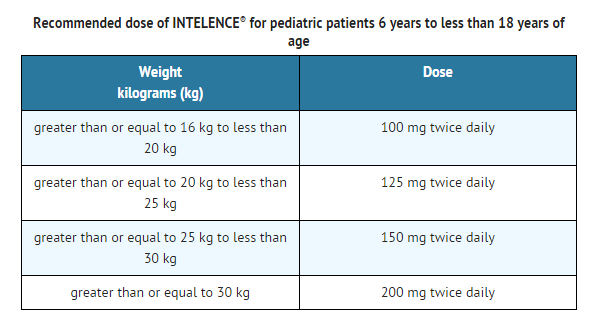
- The safety and efficacy of INTELENCE® have not been established in children less than 6 years of age
DOSAGE FORMS AND STRENGTHS
INTELENCE® 25 mg Tablets
- INTELENCE® 25 mg tablets are supplied as white to off-white, oval, scored tablets debossed with "TMC" on one side.
INTELENCE® 100 mg Tablets
- INTELENCE® 100 mg tablets are supplied as white to off-white oval tablets debossed with "TMC125" on one side and "100" on the other side.
INTELENCE® 200 mg Tablets
- INTELENCE® 200 mg tablets are supplied as white to off-white, biconvex, oblong tablets debossed with "T200" on one side.
Off-Label Use and Dosage (Pediatric)
Guideline-Supported Use
There is limited information regarding Off-Label Guideline-Supported Use of Etravirine in pediatric patients.
Non–Guideline-Supported Use
There is limited information regarding Off-Label Non–Guideline-Supported Use of Etravirine in pediatric patients.
Contraindications
- None
Warnings
Severe Skin and Hypersensitivity Reactions
- Severe, potentially life-threatening, and fatal skin reactions have been reported. These include cases of Stevens-Johnson syndrome, toxic epidermal necrolysis and erythema multiforme. Hypersensitivity reactions including drug rash with eosinophilia and systemic symptoms (DRESS) have also been reported and were characterized by rash, constitutional findings, and sometimes organ dysfunction, including hepatic failure. In Phase 3 clinical trials, Grade 3 and 4 rashes were reported in 1.3% of subjects receiving INTELENCE® compared to 0.2% of placebo subjects. A total of 2.2% of HIV-1-infected subjects receiving INTELENCE® discontinued from Phase 3 trials due to rash. Rash occurred most commonly during the first 6 weeks of therapy. The incidence of rash was higher in females.
- Discontinue INTELENCE® immediately if signs or symptoms of severe skin reactions or hypersensitivity reactions develop (including, but not limited to, severe rash or rash accompanied by fever, general malaise, fatigue, muscle or joint aches, blisters, oral lesions, conjunctivitis, facial edema, hepatitis, eosinophilia, angioedema). Clinical status including liver transaminases should be monitored and appropriate therapy initiated. Delay in stopping INTELENCE® treatment after the onset of severe rash may result in a life-threatening reaction.
Fat Redistribution
- Redistribution/accumulation of body fat, including central obesity, dorso cervical fat enlargement (buffalo hump), peripheral wasting, facial wasting, breast enlargement, and "cushingoid appearance" have been observed in patients receiving antiretroviral therapy. The mechanism and long-term consequences of these events are currently unknown. A causal relationship has not been established.
Immune Reconstitution Syndrome
- Immune reconstitution syndrome has been reported in patients treated with combination antiretroviral therapy, including INTELENCE®. During the initial phase of combination antiretroviral treatment, patients whose immune system responds may develop an inflammatory response to indolent or residual opportunistic infections (such as Mycobacterium avium infection, cytomegalovirus, Pneumocystis jiroveci pneumonia (PCP) or tuberculosis), which may necessitate further evaluation and treatment.
- Autoimmune disorders (such as Graves' disease, polymyositis, and Guillain-Barré syndrome) have also been reported to occur in the setting of immune reconstitution; however, the time to onset is more variable, and can occur many months after initiation of treatment.
Adverse Reactions
Clinical Trials Experience
- The following adverse reactions are described in greater detail in other sections:
- Severe skin and hypersensitivity reactions
Clinical Trials Experience: Adults
- Because clinical trials are conducted under widely varying conditions, adverse reaction rates observed in the clinical trials of a drug cannot be directly compared to rates in the clinical trials of another drug and may not reflect the rates observed in practice.
- The safety assessment is based on all data from 1203 subjects in the Phase 3 placebo-controlled trials, TMC125-C206 and TMC125-C216, conducted in antiretroviral treatment-experienced HIV-1-infected adult subjects, 599 of whom received INTELENCE® (200 mg twice daily). In these pooled trials, the median exposure for subjects in the INTELENCE® arm and placebo arm was 52.3 and 51.0 weeks, respectively. Discontinuations due to adverse drug reactions (ADRs) were 5.2% in the INTELENCE® arm and 2.6% in the placebo arm.
- The most frequently reported ADR at least Grade 2 in severity was rash (10.0%). Stevens-Johnson syndrome, drug hypersensitivity reaction and erythema multiforme were reported in less than 0.1% of subjects during clinical development with INTELENCE® [see WARNINGS AND PRECAUTIONS (5.1)]. A total of 2.2% of HIV-1-infected subjects in Phase 3 trials receiving INTELENCE® discontinued due to rash. In general, in clinical trials, rash was mild to moderate, occurred primarily in the second week of therapy, and was infrequent after Week 4. Rash generally resolved within 1 to 2 weeks on continued therapy. The incidence of rash was higher in women compared to men in the INTELENCE® arm in the Phase 3 trials (rash ≥ Grade 2 was reported in 9/60 [15.0%] women versus 51/539 [9.5%] men; discontinuations due to rash were reported in 3/60 [5.0%] women versus 10/539 [1.9%] men). Patients with a history of NNRTI-related rash did not appear to be at increased risk for the development of INTELENCE®-related rash compared to patients without a history of NNRTI-related rash.
Common Adverse Reactions
- Clinical ADRs of moderate intensity or greater (greater than or equal to Grade 2) and reported in at least 2% of subjects treated with INTELENCE® and occurring at a higher rate compared to placebo (excess of 1%) are presented in Table 1. Laboratory abnormalities considered ADRs are included in Table 2.
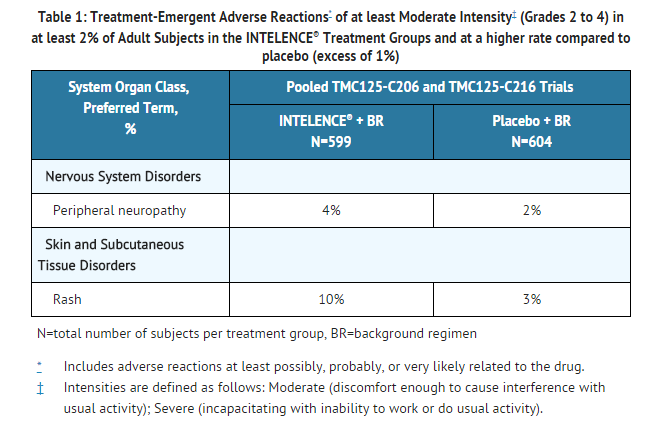
Less Common Adverse Reactions
- Treatment-emergent ADRs occurring in less than 2% of subjects (599 subjects) receiving INTELENCE® and of at least moderate intensity (greater than or equal to Grade 2) are listed below by body system:
- Cardiac Disorders: myocardial infarction, angina pectoris, atrial fibrillation
- Ear and Labyrinth Disorders: vertigo
- Eye Disorders: blurred vision
- Gastrointestinal Disorders: gastroesophageal reflux disease, flatulence, gastritis, abdominal distension, pancreatitis, constipation, dry mouth, hematemesis, retching, stomatitis
- General Disorders and Administration Site Conditions: sluggishness
- Hematologic Disorders: hemolytic anemia
- Hepatobiliary Disorders: hepatic failure, hepatomegaly, cytolytic hepatitis, hepatic steatosis, hepatitis
- Immune System Disorders: drug hypersensitivity, immune reconstitution syndrome
- Metabolism and Nutrition Disorders: diabetes mellitus, anorexia, dyslipidemia
- Nervous System Disorders: paraesthesia, somnolence, convulsion, hypoesthesia, amnesia, syncope, disturbance in attention, hypersomnia, tremor
- Psychiatric Disorders: anxiety, sleep disorders, abnormal dreams, confusional state, disorientation, nervousness, nightmares
- Renal and Urinary Disorders: acute renal failure
- Reproductive System and Breast Disorders: gynecomastia
- Respiratory,Thoracic and Mediastinal Disorders: exertional dyspnea, bronchospasm
- Skin and Subcutaneous Tissue Disorders: night sweats, lipohypertrophy, prurigo, hyperhidrosis, dry skin, swelling face
- Additional ADRs of at least moderate intensity observed in other trials were acquired lipodystrophy, angioneurotic edema, erythema multiforme and haemorrhagic stroke, each reported in no more than 0.5% of subjects.
Laboratory Abnormalities in Treatment-Experienced Patients
Selected Grade 2 to Grade 4 laboratory abnormalities that represent a worsening from baseline observed in adult subjects treated with INTELENCE® are presented in Table 2.

Patients co-infected with hepatitis B and/or hepatitis C virus
- In Phase 3 trials TMC125-C206 and TMC125-C216, 139 subjects (12.3%) with chronic hepatitis B and/or hepatitis C virus co-infection out of 1129 subjects were permitted to enroll. AST and ALT abnormalities occurred more frequently in hepatitis B and/or hepatitis C virus co-infected subjects for both treatment groups. Grade 2 or higher laboratory abnormalities that represent a worsening from baseline of AST, ALT or total bilirubin occurred in 27.8%, 25.0% and 7.1% respectively, of INTELENCE®-treated co-infected subjects as compared to 6.7%, 7.5% and 1.8% of non-co-infected INTELENCE®-treated subjects. In general, adverse events reported by INTELENCE®-treated subjects with hepatitis B and/or hepatitis C virus co-infection were similar to INTELENCE®-treated subjects without hepatitis B and/or hepatitis C virus co-infection.
Clinical Trials Experience: Pediatric Subjects (6 years to less than 18 years of age)
- The safety assessment in children and adolescents is based on the Week 24 analysis of the single-arm, Phase 2 trial TMC125-C213 in which 101 antiretroviral treatment-experienced HIV-1 infected subjects 6 years to less than 18 years of age and weighing at least 16 kg received INTELENCE® in combination with other antiretroviral agents. The frequency, type and severity of adverse drug reactions in pediatric subjects were comparable to those observed in adult subjects, except for rash which was observed more frequently in pediatric subjects. The most common adverse drug reactions in at least 2% of pediatric subjects were rash and diarrhea. Rash was reported more frequently in female subjects than in male subjects (rash ≥ Grade 2 was reported in 13/64 [20.3%] females versus 2/37 [5.4%] males; discontinuations due to rash were reported in 4/64 [6.3%] females versus 0/37 [0%] males). Rash (greater than or equal to Grade 2) occurred in 15% of pediatric subjects. In the majority of cases, rash was mild to moderate, of macular/papular type, and occurred in the second week of therapy. Rash was self-limiting and generally resolved within 1 week on continued therapy. The safety profile for subjects who completed 48 weeks of treatment was similar to the safety profile for subjects who completed 24 weeks of treatment.
Postmarketing Experience
- The following events have been identified during postmarketing use of INTELENCE®. Because these events are reported voluntarily from a population of unknown size, it is not always possible to reliably estimate their frequency or establish a causal relationship to drug exposure.
- Immune System Disorders: Severe hypersensitivity reactions including DRESS and cases of hepatic failure have been reported.
- Musculoskeletal and Connective Tissue Disorders: rhabdomyolysis
- Skin and Subcutaneous Tissue Disorders: Fatal cases of toxic epidermal necrolysis have been reported.
Drug Interactions
- Etravirine is a substrate of CYP3A, CYP2C9, and CYP2C19. Therefore, co-administration of INTELENCE® with drugs that induce or inhibit CYP3A, CYP2C9, and CYP2C19 may alter the therapeutic effect or adverse reaction profile of INTELENCE® (see TABLE 3).
- Etravirine is an inducer of CYP3A and inhibitor of CYP2C9, CYP2C19 and P-glycoprotein. Therefore, co-administration of drugs that are substrates of CYP3A, CYP2C9 and CYP2C19 or are transported by P-glycoprotein with INTELENCE® may alter the therapeutic effect or adverse reaction profile of the co-administered drug(s) (see TABLE 3).
- Table 3 shows the established and other potentially significant drug interactions based on which, alterations in dose or regimen of INTELENCE® and/or co-administered drug may be recommended. Drugs that are not recommended for co-administration with INTELENCE® are also included in Table 3.

- In addition to the drugs included in Table 3, the interaction between INTELENCE® and the following drugs were evaluated in clinical studies and no dose adjustment is needed for either drug: didanosine, enfuvirtide (ENF),ethinylestradiol/norethindrone, omeprazole, paroxetine, raltegravir, ranitidine, and tenofovir disoproxil fumarate.
Use in Specific Populations
Pregnancy
Pregnancy Category (FDA): Pregnancy Category B
- No adequate and well-controlled studies of INTELENCE® use in pregnant women have been conducted. In addition, no pharmacokinetic studies have been conducted in pregnant patients. INTELENCE® should be used during pregnancy only if the potential benefit justifies the potential risk to the fetus.
Antiretroviral Pregnancy Registry
- To monitor maternal-fetal outcomes of pregnant women exposed to INTELENCE®, an Antiretroviral Pregnancy Registry has been established. Physicians are encouraged to register patients by calling 1-800-258-4263.
Animal Data
- Reproductive and developmental toxicity studies were performed in rabbits (at oral doses up to 375 mg per kg per day) and rats (at oral doses up to 1000 mg per kg per day). In both species, no treatment-related embryo-fetal effects including malformations were observed. In addition, no treatment-related effects were observed in a separate pre- and postnatal study performed in rats at oral doses up to 500 mg per kg per day. The systemic drug exposures achieved in these animal studies were equivalent to those at the recommended human dose (400 mg per day).
Pregnancy Category (AUS):
There is no Australian Drug Evaluation Committee (ADEC) guidance on usage of Etravirine in women who are pregnant.
Labor and Delivery
There is no FDA guidance on use of Etravirine during labor and delivery.
Nursing Mothers
The Centers for Disease Control and Prevention recommend that HIV-infected mothers not breastfeed their infants to avoid risking postnatal transmission of HIV. It is not known whether etravirine is secreted in human milk. Because of both the potential for HIV transmission and the potential for adverse reactions in nursing infants, mothers should be instructed not to breastfeed if they are receiving INTELENCE®.
Pediatric Use
- Treatment with INTELENCE® is not recommended in children less than 6 years of age. The pharmacokinetics, safety, tolerability and efficacy of INTELENCE® in children less than 6 years of age have not been established.
- The safety, pharmacokinetic profile, and virologic and immunologic responses of INTELENCE® were evaluated in treatment-experienced HIV-1-infected pediatric subjects 6 years to less than 18 years of age and weighing at least 16 kg. Frequency, type, and severity of adverse drug reactions in pediatric subjects were comparable to those observed in adults, except for rash.
Geriatic Use
- Clinical studies of INTELENCE® did not include sufficient numbers of subjects aged 65 and over to determine whether they respond differently from younger subjects. Other reported clinical experience has not identified differences in responses between the elderly and younger subjects. In general, dose selection for an elderly patient should be cautious, reflecting the greater frequency of decreased hepatic, renal, or cardiac function, and of concomitant disease or other drug therapy.
Gender
There is no FDA guidance on the use of Etravirine with respect to specific gender populations.
Race
There is no FDA guidance on the use of Etravirine with respect to specific racial populations.
Renal Impairment
- Since the renal clearance of etravirine is negligible (less than 1.2%), a decrease in total body clearance is not expected in patients with renal impairment. No dose adjustments are required in patients with renal impairment. As etravirine is highly bound to plasma proteins, it is unlikely that it will be significantly removed by hemodialysis or peritoneal dialysis.
Hepatic Impairment
No dose adjustment of INTELENCE® is required in patients with mild (Child-Pugh Class A) or moderate (Child-Pugh Class B) hepatic impairment. The pharmacokinetics of INTELENCE® have not been evaluated in patients with severe hepatic impairment (Child-Pugh Class C).
Females of Reproductive Potential and Males
There is no FDA guidance on the use of Etravirine in women of reproductive potentials and males.
Immunocompromised Patients
There is no FDA guidance one the use of Etravirine in patients who are immunocompromised.
Administration and Monitoring
Administration
- Oral
Method of Administration
- Patients should be instructed to swallow the INTELENCE® tablet(s) whole with a liquid such as water. Patients who are unable to swallow the INTELENCE® tablet(s) whole may disperse the tablet(s) in a glass of water. The patient should be instructed to do the following:
- Place the tablet(s) in 5 mL (1 teaspoon) of water, or at least enough liquid to cover the medication,
- Stir well until the water looks milky,
- If desired, add more water or alternatively orange juice or milk (patients should not place the tablets in orange juice or milk without first adding water). The use of grapefruit juice or warm (greater than 40°C) or carbonated beverages should be avoided.
- Drink it immediately,
- Rinse the glass several times with water, orange juice, or milk and completely swallow the rinse each time to make sure the patient takes the entire dose.
Monitoring
There is limited information regarding Monitoring of Etravirine in the drug label.
IV Compatibility
There is limited information regarding IV Compatibility of Etravirine in the drug label.
Overdosage
- There is no specific antidote for overdose with INTELENCE®. Human experience of overdose with INTELENCE® is limited. The highest dose studied in healthy volunteers was 400 mg once daily. Treatment of overdose with INTELENCE® consists of general supportive measures including monitoring of vital signs and observation of the clinical status of the patient. If indicated, elimination of unabsorbed active substance is to be achieved by emesis or gastric lavage. Administration of activated charcoal may also be used to aid in removal of unabsorbed active substance. Because etravirine is highly protein bound, dialysis is unlikely to result in significant removal of the active substance.
Pharmacology

Mechanism of Action
- Etravirine is an NNRTI of human immunodeficiency virus type 1 (HIV-1). Etravirine binds directly to reverse transcriptase (RT) and blocks the RNA-dependent and DNA-dependent DNA polymerase activities by causing a disruption of the enzyme's catalytic site. Etravirine does not inhibit the human DNA polymerases α, β, and γ.
Structure
- INTELENCE® (etravirine) is a non-nucleoside reverse transcriptase inhibitor (NNRTI) of human immunodeficiency virus type 1 (HIV-1).
- The chemical name for etravirine is 4-[[6-amino-5-bromo-2-(4-cyanophenyl)amino-4-pyrimidinyl]oxy]]-3,5-dimethylbenzonitrile. Its molecular formula is C20H15BrN6O and its molecular weight is 435.28. Etravirine has the following structural formula:
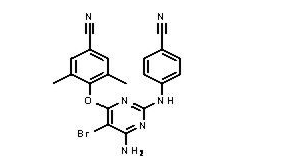
- Etravirine is a white to slightly yellowish brown powder. Etravirine is practically insoluble in water over a wide pH range. It is very slightly soluble in propylene glycol and slightly soluble in ethanol. Etravirine is soluble in polyethylene glycol (PEG)400 and freely soluble in some organic solvents (e.g., N,N-dimethylformamide and tetrahydrofuran).
- INTELENCE® 25 mg tablets are available as white to off-white, oval scored tablets for oral administration. Each 25 mg tablet contains 25 mg of etravirine and the inactive ingredients hypromellose, microcrystalline cellulose, colloidal silicon dioxide, croscarmellose sodium, magnesium stearate and lactose monohydrate.
- INTELENCE® 100 mg tablets are available as white to off-white, oval tablets for oral administration. Each 100 mg tablet contains 100 mg of etravirine and the inactive ingredients hypromellose, microcrystalline cellulose, colloidal silicon dioxide, croscarmellose sodium, magnesium stearate and lactose monohydrate.
- INTELENCE® 200 mg tablets are available as white to off-white, biconvex, oblong tablets for oral administration. Each 200 mg tablet contains 200 mg of etravirine and the inactive ingredients hypromellose, silicified microcrystalline cellulose, microcrystalline cellulose, colloidal silicon dioxide, croscarmellose sodium and magnesium stearate.
Pharmacodynamics
Effects on Electrocardiogram
- In a randomized, double-blind, active, and placebo-controlled crossover study, 41 healthy subjects were administered INTELENCE® 200 mg twice daily, INTELENCE® 400 mg once daily, placebo, and moxifloxacin 400 mg. After 8 days of dosing, etravirine did not prolong the QT interval. The maximum mean (upper 1-sided 95% CI) baseline and placebo-adjusted QTcF were 0.6 ms (3.3 ms) for 200 mg twice daily and -1.0 ms (2.5 ms) for 400 mg once daily dosing regimens.
Pharmacokinetics
Pharmacokinetics in Adults
- The pharmacokinetic properties of INTELENCE® were determined in healthy adult subjects and in treatment-experienced HIV-1-infected adult and pediatric subjects. The systemic exposures (AUC) to etravirine were lower in HIV-1-infected subjects than in healthy subjects.
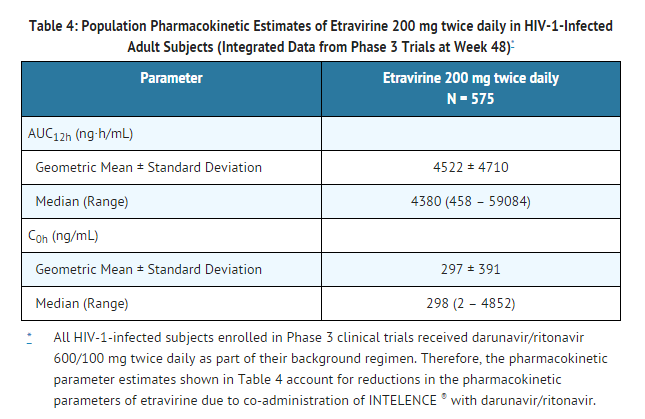
- Note: The median protein binding adjusted EC50 for MT4 cells infected with HIV-1/IIIB in vitro equals 4 ng per mL.
Absorption and Bioavailability
- Following oral administration, etravirine was absorbed with a Tmax of about 2.5 to 4 hours. The absolute oral bioavailability of INTELENCE® is unknown.
- In healthy subjects, the absorption of etravirine is not affected by co-administration of oral ranitidine or omeprazole, drugs that increase gastric pH.
Effects of Food on Oral Absorption
- The systemic exposure (AUC) to etravirine was decreased by about 50% when INTELENCE® was administered under fasting conditions, as compared to when INTELENCE® was administered following a meal. Therefore, INTELENCE® should always be taken following a meal. Within the range of meals studied, the systemic exposures to etravirine were similar. The total caloric content of the various meals evaluated ranged from 345 kilocalories (17 grams fat) to 1160 kilocalories (70 grams fat).
Distribution
- Etravirine is about 99.9% bound to plasma proteins, primarily to albumin (99.6%) and alpha 1-acid glycoprotein (97.66% to 99.02%) in vitro. The distribution of etravirine into compartments other than plasma (e.g., cerebrospinal fluid, genital tract secretions) has not been evaluated in humans.
Metabolism
- In vitro experiments with human liver microsomes (HLMs) indicate that etravirine primarily undergoes metabolism by CYP3A, CYP2C9, and CYP2C19 enzymes. The major metabolites, formed by methyl hydroxylation of the dimethylbenzonitrile moiety, were at least 90% less active than etravirine against wild-type HIV in cell culture.
Elimination
- After single dose oral administration of 800 mg 14C-etravirine, 93.7% and 1.2% of the administered dose of 14C-etravirine was recovered in the feces and urine, respectively. Unchanged etravirine accounted for 81.2% to 86.4% of the administered dose in feces. Unchanged etravirine was not detected in urine. The mean (± standard deviation) terminal elimination half-life of etravirine was about 41 (± 20) hours.
Special Populations
Hepatic Impairment
- Etravirine is primarily metabolized by the liver. The steady state pharmacokinetic parameters of etravirine were similar after multiple dose administration of INTELENCE® to subjects with normal hepatic function (16 subjects), mild hepatic impairment (Child-Pugh Class A, 8 subjects), and moderate hepatic impairment (Child-Pugh Class B, 8 subjects). The effect of severe hepatic impairment on the pharmacokinetics of etravirine has not been evaluated.
Hepatitis B and/or Hepatitis C Virus Co-infection
- Population pharmacokinetic analysis of the TMC125-C206 and TMC125-C216 trials showed reduced clearance for etravirine in HIV-1-infected subjects with hepatitis B and/or C virus co-infection. Based upon the safety profile of INTELENCE®, no dose adjustment is necessary in patients co-infected with hepatitis B and/or C virus.
Renal Impairment
- The pharmacokinetics of etravirine have not been studied in patients with renal impairment. The results from a mass balance study with 14C-etravirine showed that less than 1.2% of the administered dose of etravirine is excreted in the urine as metabolites. No unchanged drug was detected in the urine. As etravirine is highly bound to plasma proteins, it is unlikely that it will be significantly removed by hemodialysis or peritoneal dialysis.
Gender
- No significant pharmacokinetic differences have been observed between males and females.
Race
- Population pharmacokinetic analysis of etravirine in HIV-infected subjects did not show an effect of race on exposure to etravirine.
Geriatric Patients
- Population pharmacokinetic analysis in HIV-infected subjects showed that etravirine pharmacokinetics are not considerably different within the age range (18 to 77 years) evaluated.
Pediatric Patients
- The pharmacokinetics of etravirine in 101 treatment-experienced HIV-1-infected pediatric subjects, 6 years to less than 18 years of age and weighing at least 16 kg showed that the administered weight-based dosages (approximately 5.2 mg per kg twice daily up to the adult recommended doses) resulted in etravirine exposure comparable to that in adults receiving INTELENCE® 200 mg twice daily when administered at a dose corresponding to 5.2 mg per kg twice daily. The population pharmacokinetic estimates for etravirine AUC12h and C0h are summarized in the table below.
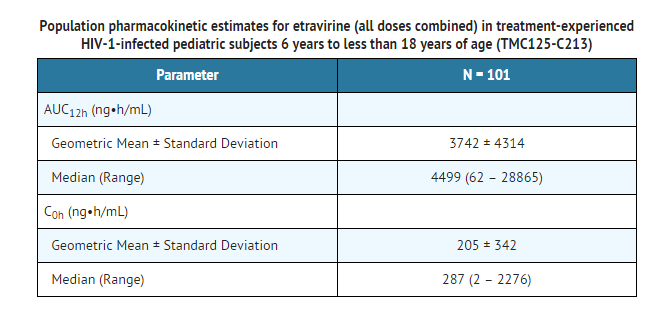
- The pharmacokinetics of etravirine in pediatric subjects less than 6 years of age have not been established.
Drug Interactions
- Etravirine is a substrate of CYP3A, CYP2C9, and CYP2C19. Therefore, co-administration of INTELENCE® with drugs that induce or inhibit CYP3A, CYP2C9, and CYP2C19 may alter the therapeutic effect or adverse reaction profile of INTELENCE®.
- Etravirine is an inducer of CYP3A and inhibitor of CYP2C9, CYP2C19 and P-glycoprotein. Therefore, co-administration of drugs that are substrates of CYP3A, CYP2C9 and CYP2C19 or are transported by P-glycoprotein with INTELENCE® may alter the therapeutic effect or adverse reaction profile of the co-administered drug(s).
- Drug interaction studies were performed with INTELENCE® and other drugs likely to be co-administered and some drugs commonly used as probes for pharmacokinetic interactions. The effects of co-administration of other drugs on the AUC, Cmax, and Cmin values of etravirine are summarized in Table 5 (effect of other drugs on INTELENCE®). The effect of co-administration of INTELENCE® on the AUC, Cmax, and Cmin values of other drugs are summarized in Table 6 (effect of INTELENCE® on other drugs).
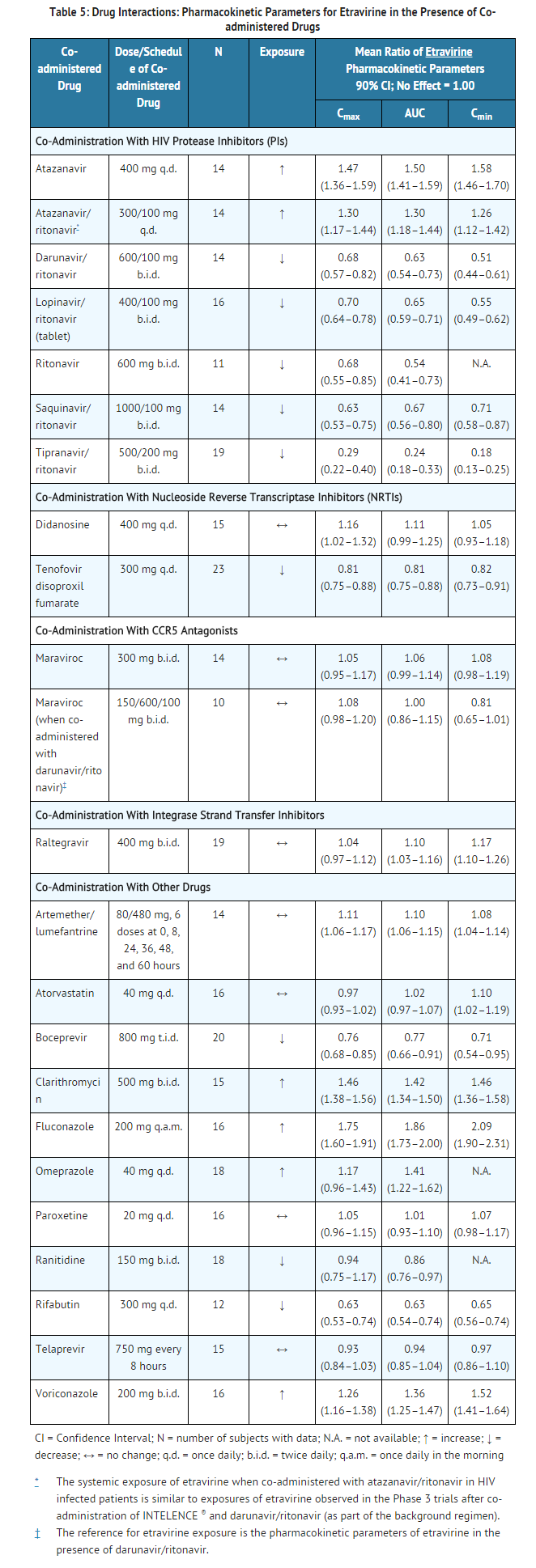

Nonclinical Toxicology
Carcinogenesis, Mutagenesis, Impairment of Fertility
Carcinogenesis
- Etravirine was evaluated for carcinogenic potential by oral gavage administration to mice and rats for up to approximately 104 weeks. Daily doses of 50, 200 and 400 mg per kg were administered to mice and doses of 70, 200 and 600 mg per kg were administered to rats in the initial period of approximately 41 to 52 weeks. The high and middle doses were subsequently adjusted due to tolerability and reduced by 50% in mice and by 50 to 66% in rats to allow for completion of the studies. In the mouse study, statistically significant increases in the incidences of hepatocellular carcinoma and incidences of hepatocellular adenomas or carcinomas combined were observed in treated females. In the rat study, no statistically significant increases in tumor findings were observed in either sex. The relevance of these liver tumor findings in mice to humans is not known. Because of tolerability of the formulation in these rodent studies, maximum systemic drug exposures achieved at the doses tested were lower than those in humans at the clinical dose (400 mg per day), with animal vs. human AUC ratios being 0.6-fold (mice) and 0.2–0.7-fold (rats).
Mutagenesis
- Etravirine tested negative in the in vitro Ames reverse mutation assay, in vitro chromosomal aberration assay in human lymphocyte, and in vitro clastogenicity mouse lymphoma assay, tested in the absence and presence of a metabolic activation system. Etravirine did not induce chromosomal damage in the in vivo micronucleus test in mice.
Impairment of Fertility
- No effects on fertility and early embryonic development were observed when etravirine was tested in rats at maternal doses up to 500 mg per kg per day, resulting in systemic drug exposure up to the recommended human dose (400 mg per day).
Clinical Studies
Treatment-Experienced Adult Subjects
- The clinical efficacy of INTELENCE® is derived from the analyses of 48-week data from 2 ongoing, randomized, double-blinded, placebo-controlled, Phase 3 trials, TMC125-C206 and TMC125-C216 (DUET-1 and DUET-2). These trials are identical in design and the results below are pooled data from the two trials.
- TMC125-C206 and TMC125-C216 are Phase 3 studies designed to evaluate the safety and antiretroviral activity of INTELENCE® in combination with a background regimen (BR) as compared to placebo in combination with a BR. Eligible subjects were treatment-experienced HIV-1-infected patients with plasma HIV-1 RNA greater than 5000 copies per mL while on an antiretroviral regimen for at least 8 weeks. In addition, subjects had 1 or more NNRTI resistance-associated mutations at screening or from prior genotypic analysis, and 3 or more of the following primary PI mutations at screening: D30N, V32I, L33F, M46I/L, I47A/V, G48V, I50L/V, V82A/F/L/S/T, I84V, N88S, or L90M. Randomization was stratified by the intended use of enfuvirtide (ENF) in the BR, previous use of darunavir/ritonavir (DRV/rtv), and screening viral load. Virologic response was defined as HIV-1 RNA less than 50 copies per mL at Week 48.
- All study subjects received DRV/rtv as part of their BR, and at least 2 other investigator-selected antiretroviral drugs (N[t]RTIs with or without ENF). Of INTELENCE®-treated subjects, 25.5% used ENF for the first time (de novo) and 20.0% re-used ENF. Of placebo-treated subjects, 26.5% used de novo ENF and 20.4% re-used ENF.
- In the pooled analysis for TMC125-C206 and TMC125-C216, demographics and baseline characteristics were balanced between the INTELENCE® arm and the placebo arm. Table 10 displays selected demographic and baseline disease characteristics of the subjects in the INTELENCE® and placebo arms.

- Efficacy at Week 48 for subjects in the INTELENCE® and placebo arms for the pooled TMC125-C206 and TMC125-C216 study populations are shown in Table 11.
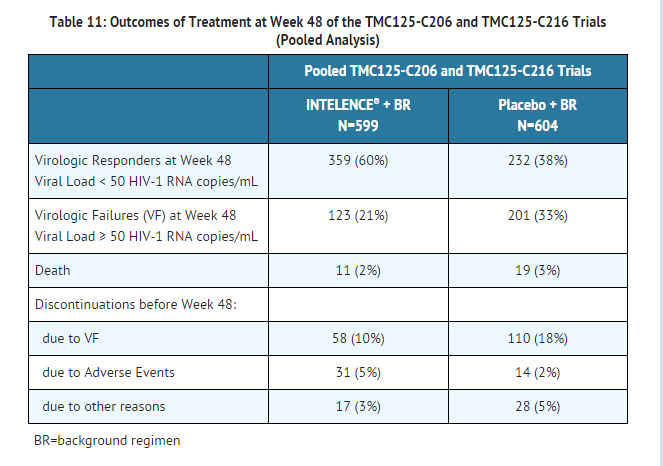
- At Week 48, 70.8% of INTELENCE®-treated subjects achieved HIV-1 RNA less than 400 copies per mL as compared to 46.4% of placebo-treated subjects. The mean decrease in plasma HIV-1 RNA from baseline to Week 48 was -2.23 log10 copies per mL for INTELENCE®-treated subjects and -1.46 log10 copies per mL for placebo-treated subjects. The mean CD4+ cell count increase from baseline for INTELENCE®-treated subjects was 96 cells per mm3 and 68 cells per mm3 for placebo-treated subjects.
- Of the study population who either re-used or did not use ENF, 57.4% of INTELENCE®-treated subjects and 31.7% of placebo-treated subjects achieved HIV-1 RNA less than 50 copies per mL. Of the study population using ENF de novo, 67.3% of INTELENCE®-treated subjects and 57.2% of placebo-treated subjects achieved HIV-1 RNA less than 50 copies per mL.
- Treatment-emergent CDC category C events occurred in 4% of INTELENCE®-treated subjects and 8.4% of placebo-treated subjects.
- Study TMC125-C227 was a randomized, exploratory, active-controlled, open-label, Phase 2b trial. Eligible subjects were treatment-experienced, PI-naïve HIV-1-infected patients with genotypic evidence of NNRTI resistance at screening or from prior genotypic analysis. The virologic response was evaluated in 116 subjects who were randomized to INTELENCE® (59 subjects) or an investigator-selected PI (57 subjects), each given with 2 investigator-selected N(t)RTIs. INTELENCE®-treated subjects had lower antiviral responses associated with reduced susceptibility to the N(t)RTIs and to INTELENCE® as compared to the control PI-treated subjects.
Treatment-Experienced Pediatric Subjects (6 years to less than 18 years of age)
- TMC125-C213, a single-arm, Phase 2 trial evaluating the pharmacokinetics, safety, tolerability, and efficacy of INTELENCE® enrolled 101 antiretroviral treatment-experienced HIV-1 infected pediatric subjects 6 years to less than 18 years of age and weighing at least 16 kg. Subjects eligible for this trial were on an antiretroviral regimen with confirmed plasma HIV-1 RNA of at least 500 copies per mL and viral susceptibility to INTELENCE® at screening.
- The median baseline plasma HIV-1 RNA was 3.9 log10 copies per mL, and the median baseline CD4 cell count was 385 × 106 cells per mm3.
- At Week 24, 52% of all pediatric subjects had HIV-1 RNA less than 50 copies per mL. The proportion of pediatric subjects with HIV-1 RNA less than 400 copies per mL was 67%. The mean CD4 cell count increase from baseline was 112 × 106 cells per mm3.
How Supplied
- INTELENCE® 25 mg tablets are supplied as white to off-white, oval, scored tablets containing 25 mg of etravirine. Each tablet is debossed with "TMC" on one side.
- INTELENCE® 100 mg tablets are supplied as white to off-white, oval tablets containing 100 mg of etravirine. Each tablet is debossed with "TMC125" on one side and "100" on the other side.
- INTELENCE® 200 mg tablets are supplied as white to off-white, biconvex, oblong tablets containing 200 mg of etravirine. Each tablet is debossed with "T200" on one side.
- INTELENCE® tablets are packaged in bottles in the following configuration:
- 25 mg tablets—bottles of 120 (NDC 59676-572-01). Each bottle contains 2 desiccant pouches.
- 100 mg tablets—bottles of 120 (NDC 59676-570-01). Each bottle contains 3 desiccant pouches.
- 200 mg tablets—bottles of 60 (NDC 59676-571-01). Each bottle contains 3 desiccant pouches.
Storage
- Store INTELENCE® tablets at 25°C (77°F); with excursions permitted to 15°to 30°C (59°to 86°F) [see USP controlled room temperature]. Store in the original bottle. Keep the bottle tightly closed in order to protect from moisture. Do not remove the desiccant pouches.
Images
Drug Images
{{#ask: Page Name::Etravirine |?Pill Name |?Drug Name |?Pill Ingred |?Pill Imprint |?Pill Dosage |?Pill Color |?Pill Shape |?Pill Size (mm) |?Pill Scoring |?NDC |?Drug Author |format=template |template=DrugPageImages |mainlabel=- |sort=Pill Name }}
Package and Label Display Panel


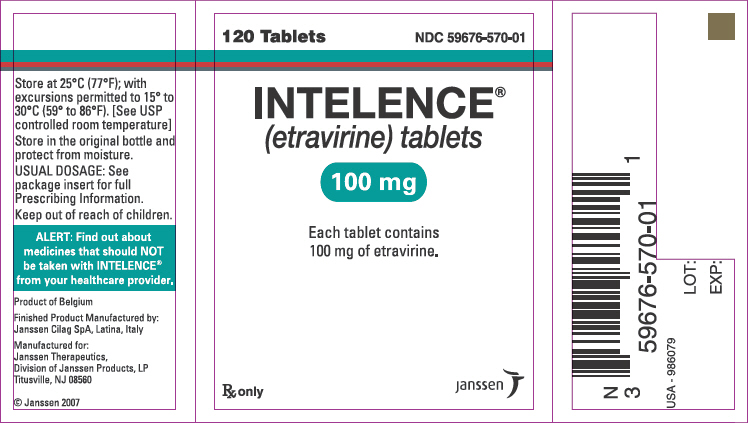
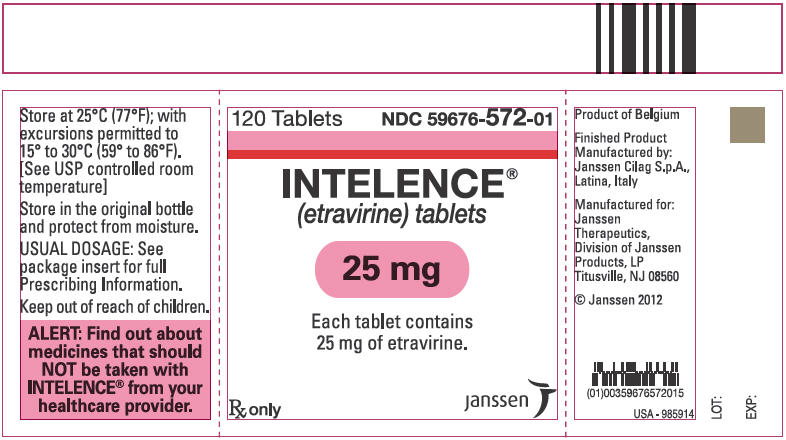
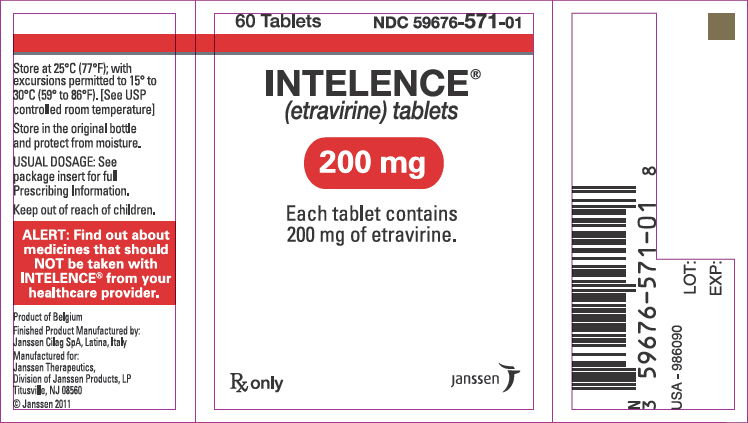
{{#ask: Label Page::Etravirine |?Label Name |format=template |template=DrugLabelImages |mainlabel=- |sort=Label Page }}
Patient Counseling Information
- A statement to patients and healthcare providers is included on the product's bottle label: ALERT: Find out about medicines that should NOT be taken with INTELENCE® from your healthcare provider. A Patient Package Insert for INTELENCE® is available for patient information.
- Patients should be informed that INTELENCE® is not a cure for HIV infection and that they may continue to develop opportunistic infections and other complications associated with HIV disease. Patients should be told that sustained decreases in plasma HIV RNA have been associated with a reduced risk of progression to AIDS and death. Patients should remain under the care of a physician while using INTELENCE®.
- Patients should be advised to avoid doing things that can spread HIV-1 infection to others. Patients should be advised to practice safe sex and to use latex or polyurethane condoms to lower the chance of sexual contact with any body fluids such as semen, vaginal secretions or blood. Patients should also be advised to never re-use or share needles or other injection equipment, or share personal items that can have blood or body fluids on them, such as toothbrushes and razor blades.
- Patients should be advised to take INTELENCE® following a meal twice a day as prescribed. The type of food does not affect the exposure to etravirine.
- Patients should be instructed to swallow the INTELENCE® tablet(s) whole with a liquid such as water. Patients should be instructed not to chew the tablets. Patients who are unable to swallow the INTELENCE® tablet(s) whole may disperse the tablet(s) in a glass of water. The patient should be instructed to do the following:
- Place the tablet(s) in 5 mL (1 teaspoon) of water, or at least enough liquid to cover the medication,
- Stir well until the water looks milky
- If desired, add more water or alternatively orange juice or milk (patients should not place the tablets in orange juice or milk without first adding water). The use of grapefruit juice or warm (greater than 104°F; greater than 40°C) or carbonated beverages should be avoided.
- Drink it immediately,
- Rinse the glass several times with water, orange juice, or milk and completely swallow the rinse each time to make sure the patient takes the entire dose.
INTELENCE® must always be used in combination with other antiretroviral drugs. Patients should not alter the dose of INTELENCE® or discontinue therapy with INTELENCE® without consulting their physician.
- If the patient misses a dose of INTELENCE® within 6 hours of the time it is usually taken, the patient should take INTELENCE® following a meal as soon as possible, and then take the next dose of INTELENCE® at the regularly scheduled time. If a patient misses a dose of INTELENCE® by more than 6 hours of the time it is usually taken, the patient should not take the missed dose and simply resume the usual dosing schedule. Inform the patient that he or she should not take more or less than the prescribed dose of INTELENCE® at any one time.
- INTELENCE® may interact with many drugs; therefore, patients should be advised to report to their healthcare provider the use of any other prescription or nonprescription medication or herbal products, including St. John's wort.
- Patients should be informed that severe and potentially life-threatening rash has been reported with INTELENCE®. Rash has been reported most commonly in the first 6 weeks of therapy. Patients should be advised to immediately contact their healthcare provider if they develop rash. Instruct patients to immediately stop taking INTELENCE® and seek medical attention if they develop a rash associated with any of the following symptoms as it may be a sign of a more serious reaction such as Stevens-Johnson syndrome, toxic epidermal necrolysis or severe hypersensitivity: fever, generally ill feeling, extreme tiredness, muscle or joint aches, blisters, oral lesions, eye inflammation, facial swelling, swelling of the eyes, lips, mouth, breathing difficulty, and/or signs and symptoms of liver problems (e.g., yellowing of your skin or whites of your eyes, dark or tea colored urine, pale colored stools/bowel movements, nausea, vomiting, loss of appetite, or pain, aching or sensitivity on your right side below your ribs). Patients should understand that if severe rash occurs, they will be closely monitored, laboratory tests will be ordered and appropriate therapy will be initiated.
- Patients should be informed that redistribution or accumulation of body fat may occur in patients receiving antiretroviral therapy, including INTELENCE®, and that the cause and long-term health effects of these conditions are not known at this time.
Precautions with Alcohol
- Alcohol-Etravirine interaction has not been established. Talk to your doctor about the effects of taking alcohol with this medication.
Brand Names
- INTELENCE
Look-Alike Drug Names
There is limited information regarding Etravirine Look-Alike Drug Names in the drug label.
Drug Shortage Status
Price
References
The contents of this FDA label are provided by the National Library of Medicine.
{{#subobject:
|Page Name=Etravirine
|Pill Name=No image.jpg
|Drug Name=
|Pill Ingred=|+sep=;
|Pill Imprint=
|Pill Dosage={{{dosageValue}}} {{{dosageUnit}}}
|Pill Color=|+sep=;
|Pill Shape=
|Pill Size (mm)=
|Pill Scoring=
|Pill Image=
|Drug Author=
|NDC=
}}
{{#subobject:
|Label Page=Etravirine |Label Name=Patient information.png
}}
{{#subobject:
|Label Page=Etravirine |Label Name=Etravirine image2.jpg
}}
{{#subobject:
|Label Page=Etravirine |Label Name=Etravirine image1.jpg
}}
{{#subobject:
|Label Page=Etravirine |Label Name=Etravirine image.jpg
}}
{{#subobject:
|Label Page=Etravirine |Label Name=Etravirine ingredients and appearance.png
}}